If you’ve ever fallen in love with a zesty, colorful bowl of greens, radicchio, tomatoes, and yellow peppers, then this vegan Italian chopped salad is for you! It’s a plant-based spin on a classic, and it incorporates chickpeas and sun-dried tomatoes for heartiness and umami without meat. An herbed Italian dressing and cashew “Parmesan” cheese ensure that the salad is packed with flavor.
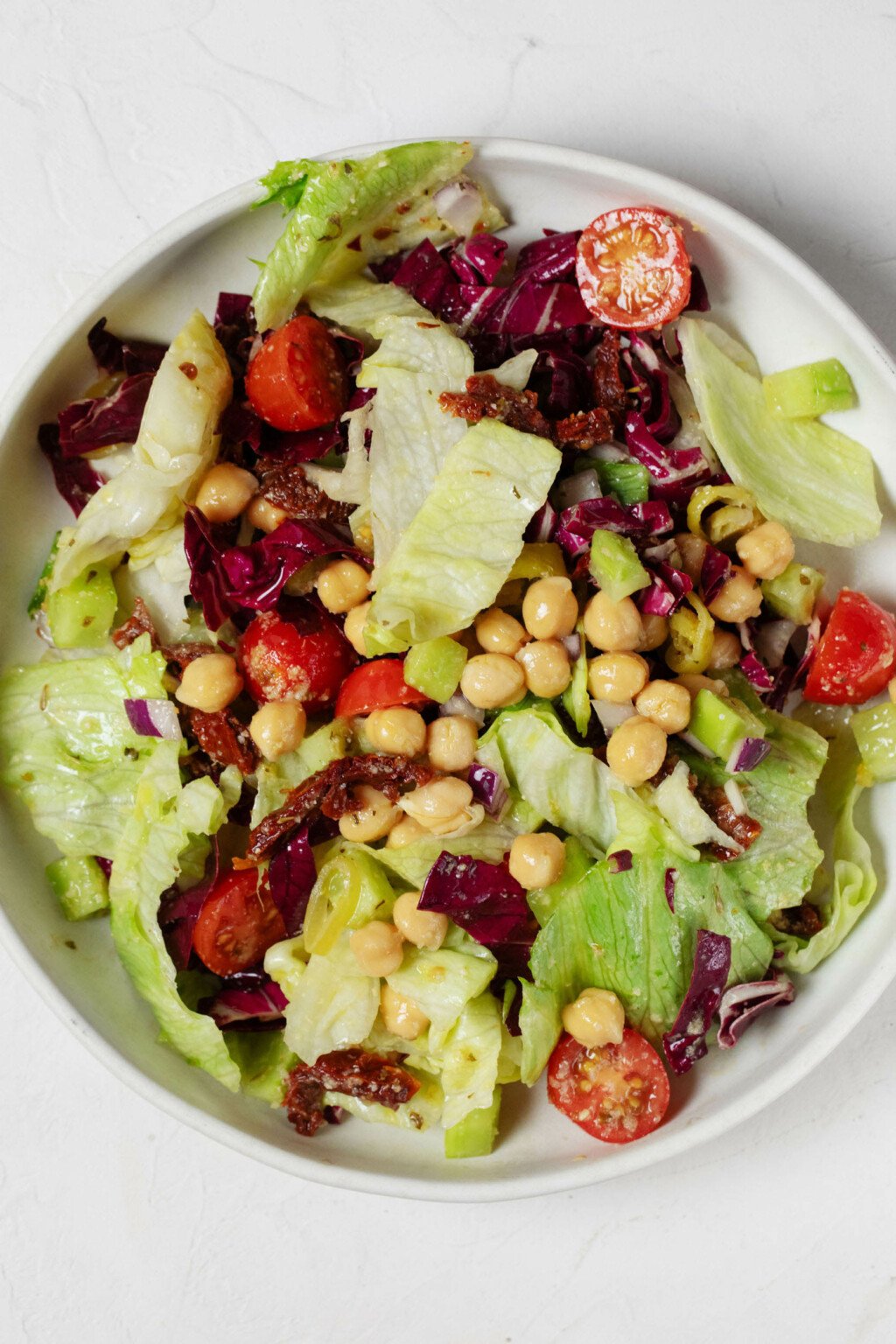
Today’s vegan Italian chopped salad is posted in honor of an annual event: my winter salad craze.
Yes, summer is usually hailed as salad season. But without fail, come January or February, I start to find myself craving salads like crazy. In fact, I crave them more right now than I ever do in the summertime.
Much as I’m enjoying winter this year, it’s a lot of time indoors.
Winter also means more brown food than usual: lots of bread, lentil soup, mushroom pasta, potatoes in literally any form, and so on.
A big, bright, colorful, crispy, and crunchy salad feels like the perfect counterbalance to many weeks of sunlessness, soup, and root vegetables.
There are winter salads, of course. I love my perfect winter chopped salad and winter panzanella salad, with its many roasted root veggies.
But the type of salads that I need to help offset the drag of winter are bursting with color. They’re boldly flavored and have lots of acid.
Most of all, they have tons of crunch. I’m thinking of my chickpea Greek salad, crispy broccoli Caesar, or even my simple butter lettuce side salad.
And what could possibly offer more crunch and color than an Italian chopped salad?
What is an Italian chopped salad?
Much like Italian dressing, Italian chopped salad is really an American recipe. It features chopped vegetables and mix-ins that are associated with Italian cuisine.
The precise combination of ingredients can vary from recipe to recipe. Most Italian chopped salad recipes will call for any combination of the following:
- Romaine and/or iceberg lettuce
- Cherry tomatoes
- Roasted or raw red peppers
- Olives
- Pepperoncini or banana peppers
- Mozzarella and/or provolone
- Salami
- Olives
- Cucumbers
- Onions
As you can see, there’s some range. I’ve even seen short, cooked pasta, like ditalini, thrown into the mix. (Not a bad idea.)
The dressing for Italian chopped salad is usually Italian vinaigrette.
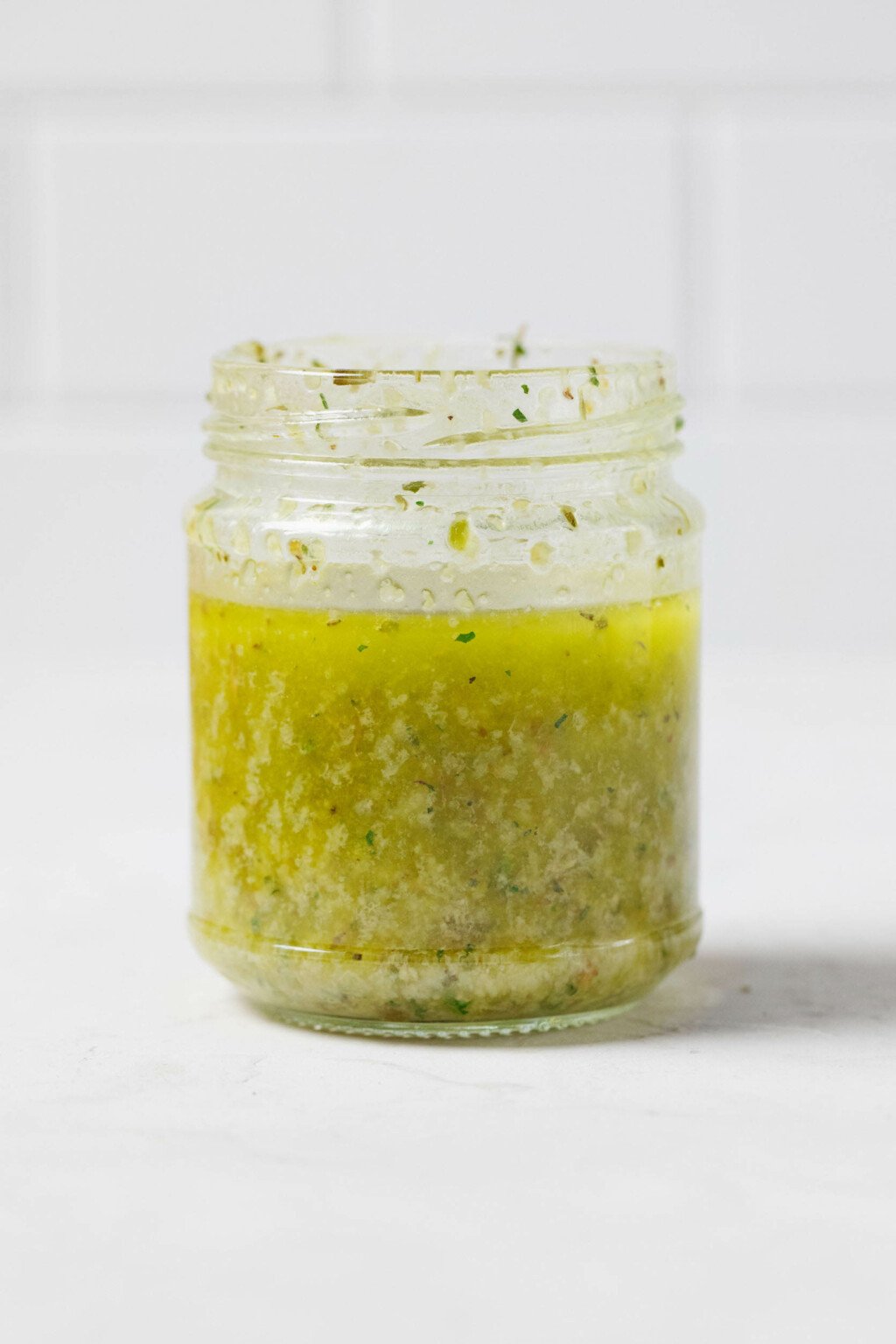
I have a vegan recipe for this. Like most Italian dressings, it’s made with olive oil, red or white wine vinegar, herbs, and a touch of sweetness; I use a scant teaspoon of maple syrup.
Chopped is part of the recipe description because most salads of this kind are chopped into similarly-sized pieces before mixing and serving.
As I was looking into the history of this recipe, I was able to trace it not to any single Italian antipasti dish, but rather to a few iconic chopped salads from Hollywood restaurants.
One of them—the OG, perhaps—is the famous La Scala chopped salad. It’s different from many Italian chopped salad recipes, but it’s certainly a relative of them.
Maybe I’ll veganize that one next!
Veganizing Italian chopped salad
Most Italian chopped salad recipes rely on salami and cheese for umami and substance. In order to make a vegan version of the recipe, I made added three intentional ingredients.
First, I added a legume, chickpeas, to the salad. I wouldn’t say that they’re a replacement or substitution for meat from a flavor or texture perspective, but the chickpeas are certainly a nutritious plant protein source.
I love chickpeas in a salad, and I also associate them with Italian fare. The pasta e ceci is possibly my favorite recipe in my cookbook, The Vegan Week.
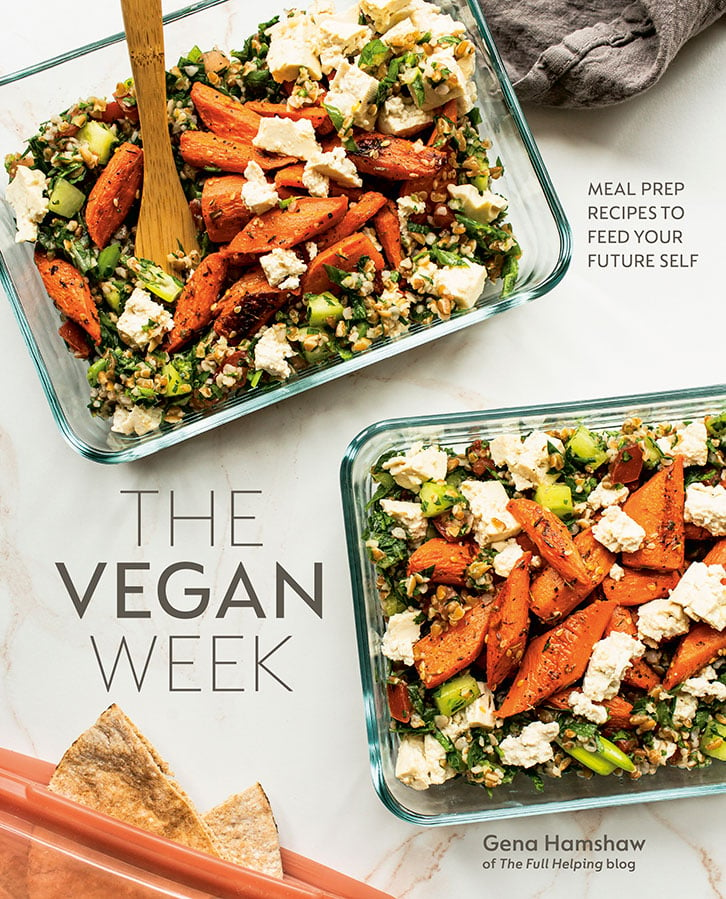
The Vegan Week
Embrace the joy of eating homemade food every day with the hearty and wholesome recipes in The Vegan Week.
Whether you have three, two, or even just one hour of time to spare, The Vegan Week will show you how to batch cook varied, colorful, and comforting dishes over the weekend.
Chickpeas help to give my vegan chopped salad heartiness, and their texture is pleasant with the other ingredients.
If you’d like to give the salad even more texture (and flavor), you could use my crispy roasted chickpeas in place of regular cooked chickpeas.
Secondly, I helped to preserve the spirit of the original dish by throwing in finely chopped, sun-dried tomatoes.
These tomatoes are super rich in umami, and umami is the savoriness and taste perception of protein that’s often associated with meat.
In addition, sun-dried tomatoes have a wonderfully concentrated, salty flavor.
Finally, I add a few big spoonfuls of my cashew parmesan cheese to the chopped salad. This “cheese” is really a finely ground mixture of cashews, nutritional yeast, and salt.
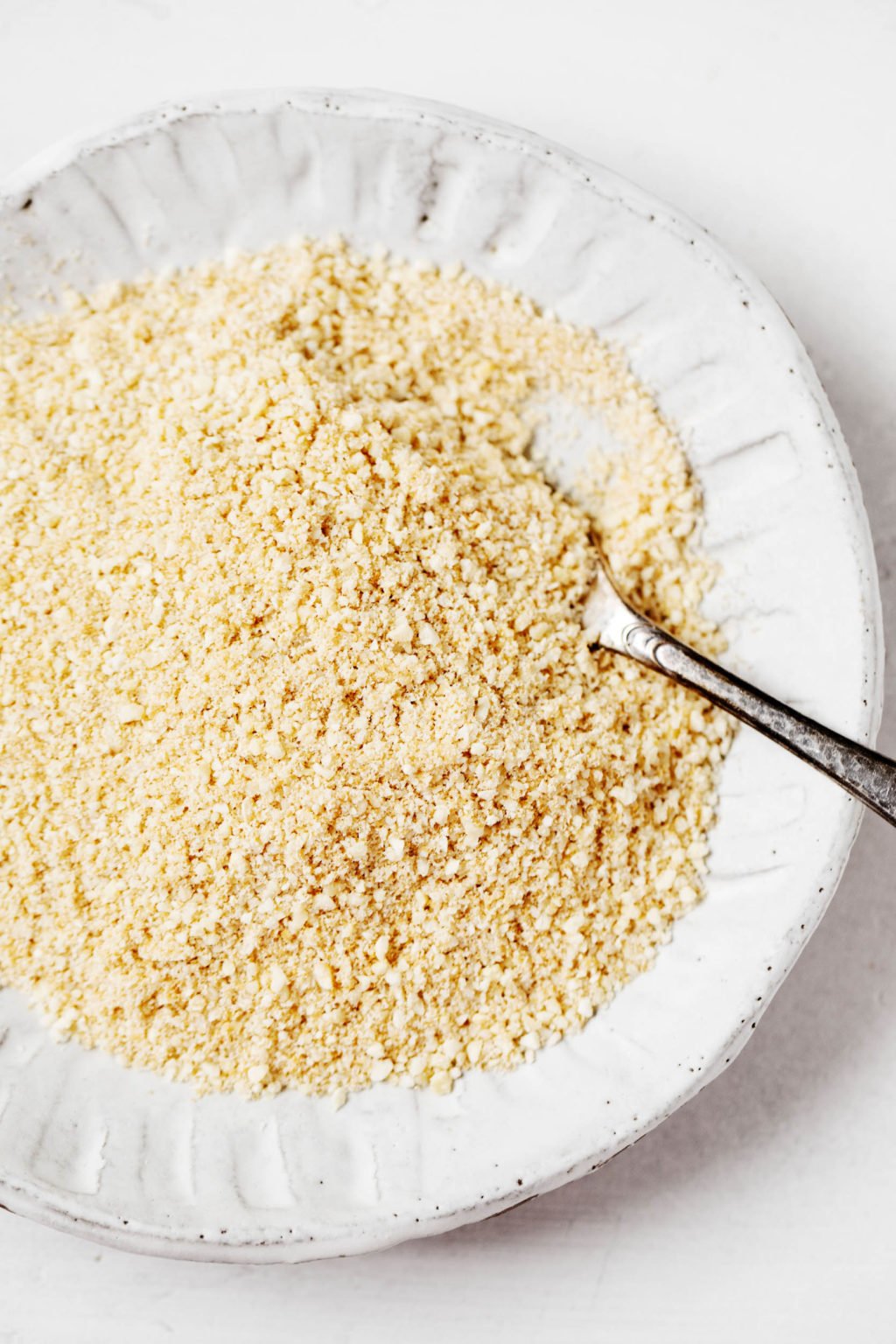
It’s a delightful, versatile topping that delivers umami and saltiness, just as grated cheese might in an omnivorous recipe.
Taken together, these ingredients help to make the vegan Italian chopped salad authentic, while allowing it to have a spirit of its own.
Ingredient notes and substitutions
As I mentioned, each version of this type of salad is bound to have its own list of ingredients. Here’s what I like to use:
- Iceberg and romaine lettuce (I like a combination of the two)
- Radicchio
- Cherry tomatoes
- Sun-dried tomatoes
- Banana peppers
- Chickpeas
- Cucumber
- Red onion
- Vegan Italian dressing
- Cashew parmesan cheese
A few notes about those components.
Sun-dried tomatoes
First, the sun-dried tomatoes. These tend to come in a few different forms.
One is whole or julienned and packed in a mixture of olive oil and herbs. That variety is fine to use for this recipe. Their marinade ought to add extra flavor.
Another type of sun-dried tomato that you might encounter is preserved, yet ready to eat. It’s easy to find this kind of sun-dried tomato if you poke around Amazon or look in stores.
They should be plump, soft, and tender, and they’re great for use in the chopped salad.
Finally, you might also come across sun-dried tomatoes that are very dry, and they’re not labeled as ready-to-eat. Instead, they require soaking in hot water in order to be reconstituted and soft enough for eating.
I don’t love this latter variety of tomato; I just don’t think they have the same intensity of flavor as the first two to begin with, and water soaking only dilutes the flavor further.
If they’re the only type of sun-dried tomato you can locate, that’s OK, but I’d try to find one of the first two options if you can.
Banana peppers
I don’t have a high tolerance for heat in food, so banana peppers are my go-to rather than pepperoncini, which are considerably spicier.
Both types of marinated yellow pepper are a standard addition to Italian chopped salad, and you can use whichever you prefer. Banana peppers are usually labeled as “mild,” and they’re not hard to find in grocery stores or online.
Red onion
The salad calls for red onion, which can be raw if that’s what is easy and what you have at home.
For less of a raw onion “bite,” you can use my 10-minute quick pickled onions instead.
Chickpeas
You can use chickpeas that are straight from a can or you can use my crispy roasted chickpeas in the recipe. If you like to soak and cook beans from dry, you’ll need about 1 1/2 cups in order to make the salad.
Vegan Italian dressing
I love the way that this dressing, which is a vinaigrette, works in the chopped salad. However, you can substitute another dressing that you love.
Two alternative ideas would be my simple Champagne vinaigrette and Greek vinaigrette. I think that an oil-based dressing works better for this particular salad than a creamy, nut-based dressing.
Salad preparation and assembly
Essentially, the preparation process for this vibrant salad is as simple as chopping—lots of chopping—and then mixing.
You’ll begin by chopping and dicing all of the main ingredients, then piling them into a good, roomy mixing bowl.
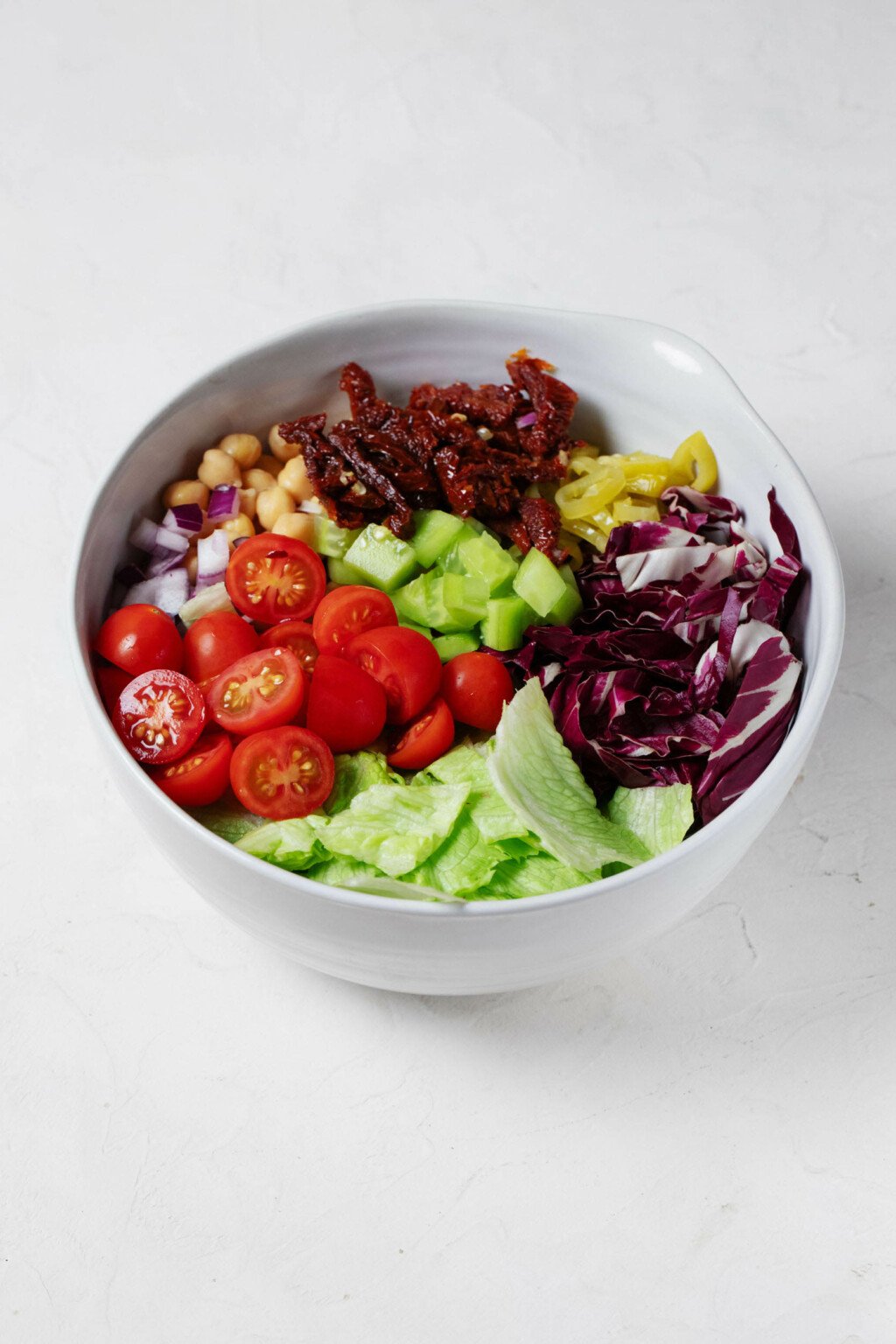
Next, it’s time to use your palate in order to season and finish dressing the salad.
I always start by adding the cashew Parmesan and about half of the dressing. I mix well and taste the salad.
To adjust the seasoning, I add any additional salt that’s needed. I also add a pinch of crushed red pepper flakes. My heat tolerance may be modest, but this salad is supposed to be zesty, after all!
Then, I add as much additional dressing as needed. The salad should be quite well dressed, but not dripping with vinaigrette.
I find that adding the dressing in stages helps me to incorporate just the right amount.
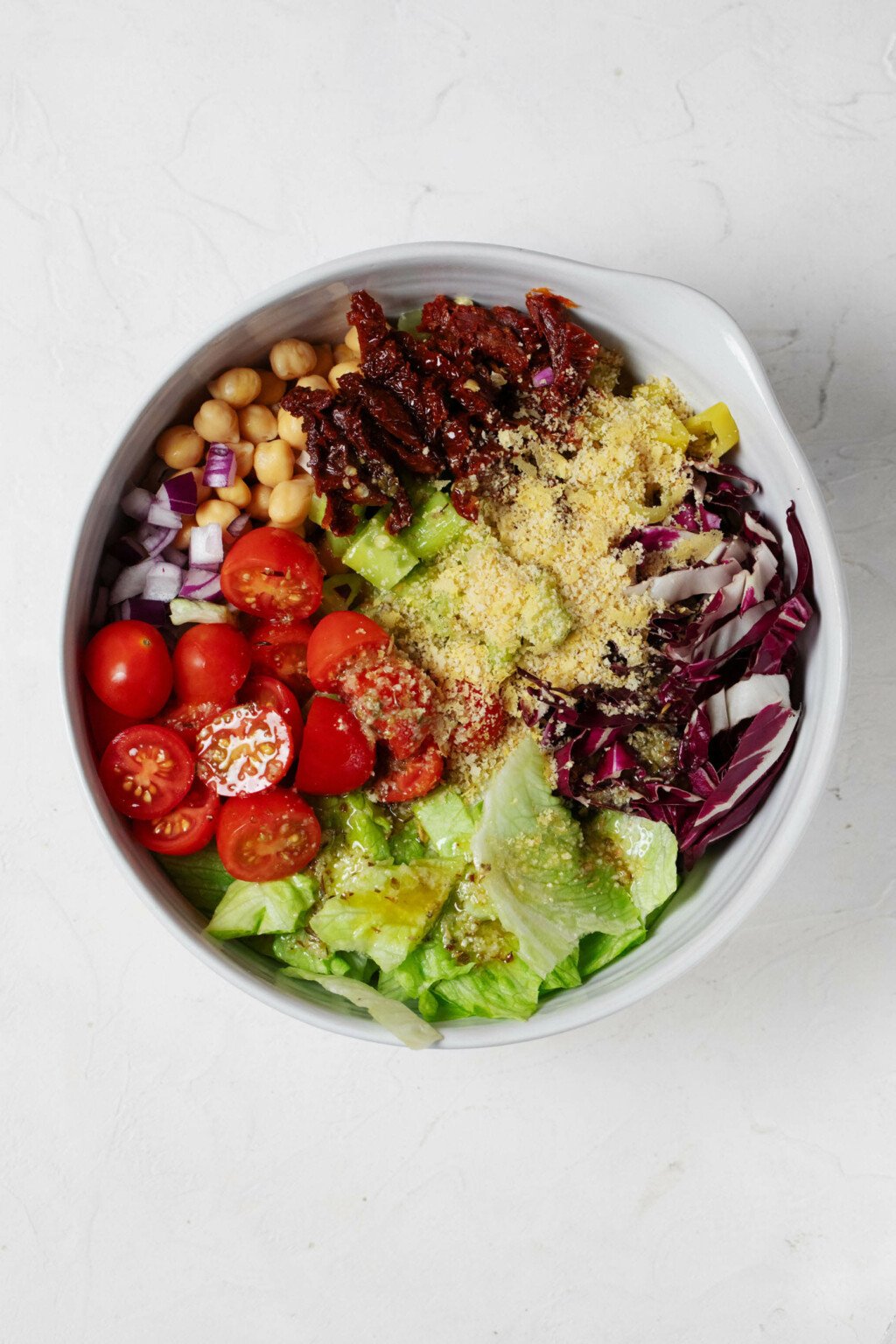
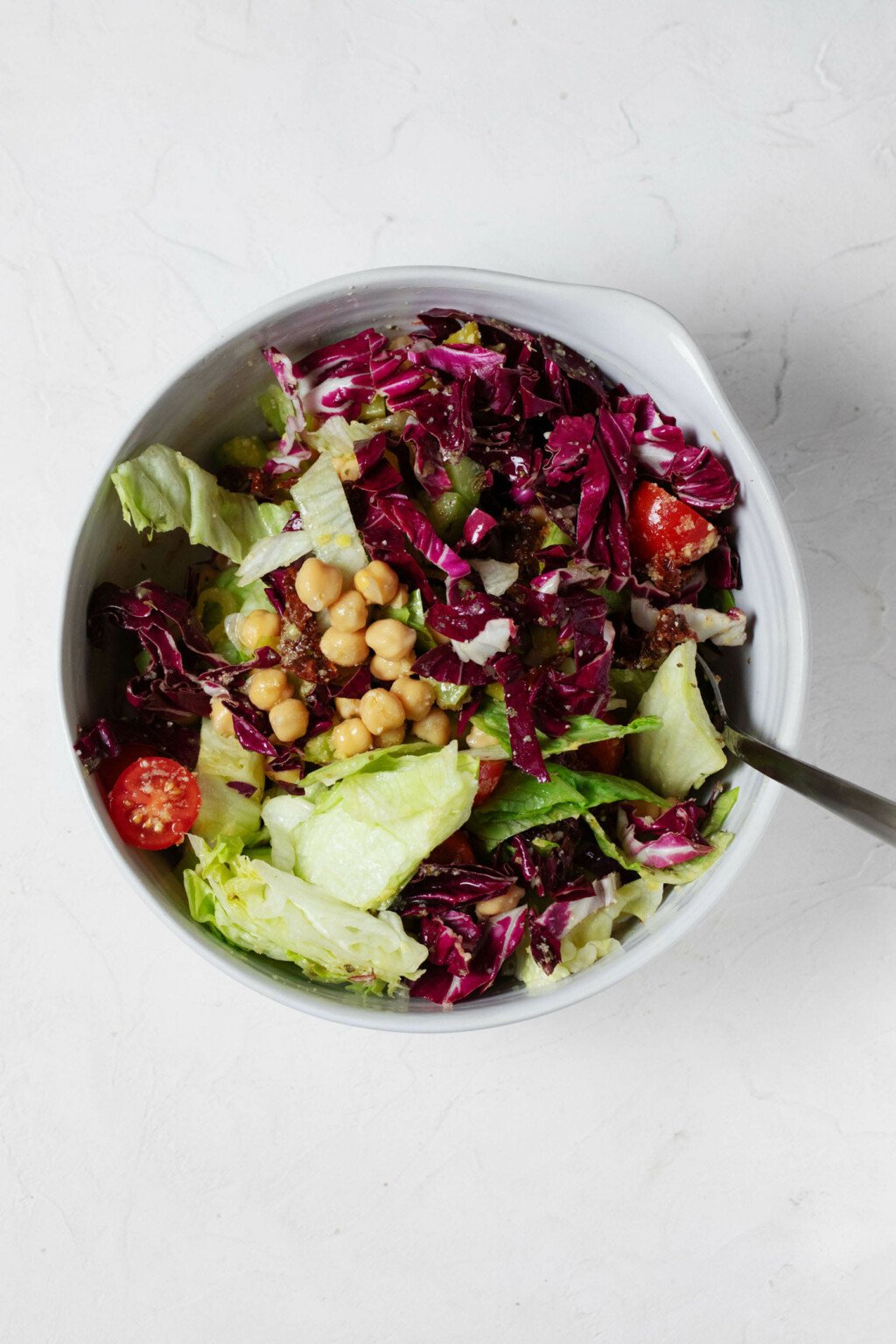
At this point, the salad is ready to serve.
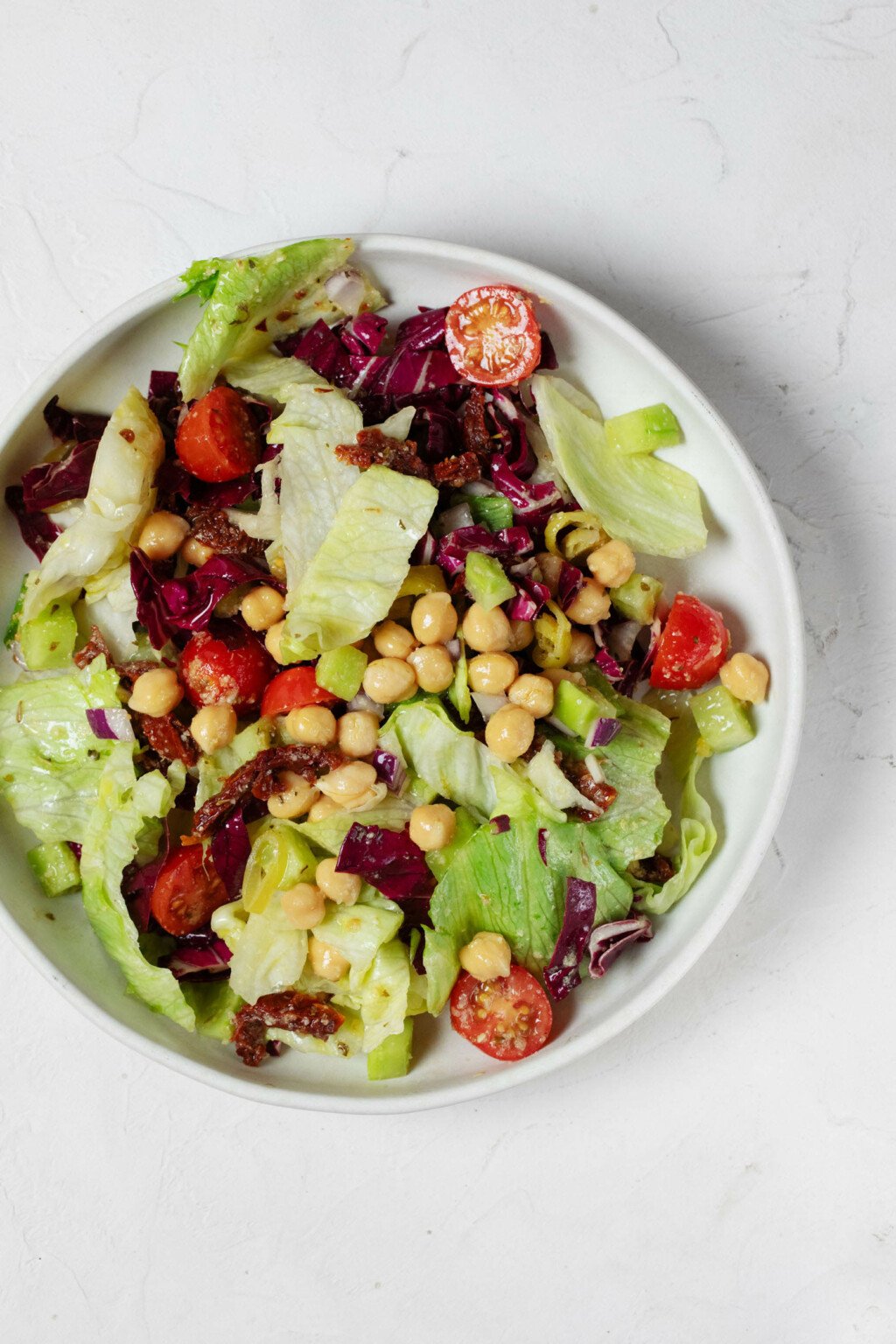
Meal prep & storage
I tend to think that this salad is best when it’s just freshly mixed, or after 1-2 days in an airtight container in the fridge.
A little bit of time to marinate actually helps all of the flavors to meld. Too much storage time can result in a limp salad.
If you need to, you can cut the recipe in half. You can also meal prep the salad by getting all of the chopping taken care of—the most laborious step in the recipe—then store the components and mix freshly when you’re ready to eat.
That’s what I do when I’m planning on serving the salad to friends, as part of a meal (I’m big on make-ahead cooking when I play hostess).
And I can vouch for the fact that the chopped salad is a big crowd pleaser.
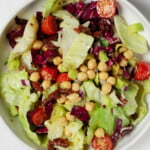
Zesty Vegan Italian Chopped Salad
Author –Ingredients
- 6 cups chopped iceberg or romaine lettuce (I like to use a combination of both)
- 2 cups chopped radicchio leaves (or another chicory)
- 1 1/2 cups halved cherry or grape tomatoes
- 1 cup (packed) julienned sun-dried tomatoes (oil-packed or ready-to-eat)
- 1 cup thinly sliced banana peppers (substitute pepperoncini for more heat)
- 1 1/2 cups cooked chickpeas (240g, or one 15-ounce / 425g can)
- 1 cup peeled and diced cucumber
- 1/4 cup diced red onion (substitute a packed 1/4 cup quick pickled onion)
- 1 batch vegan Italian dressing
- 2 tablespoons cashew parmesan cheese (more to taste)
- Crushed red pepper flakes (optional and to taste; substitute freshly ground black pepper for less heat)
Instructions
- Place all salad ingredients in a large mixing bowl. Pour 1/2 cup of dressing over the salad and add the cashew parmesan cheese. Mix the salad well.
- Taste the salad and adjust the salt and add crushed pepper flakes as needed. Add additional dressing and/or cashew parmesan cheese as needed, too. Toss the salad again. Serve right away or store in an airtight container in the fridge for up to 2 days.
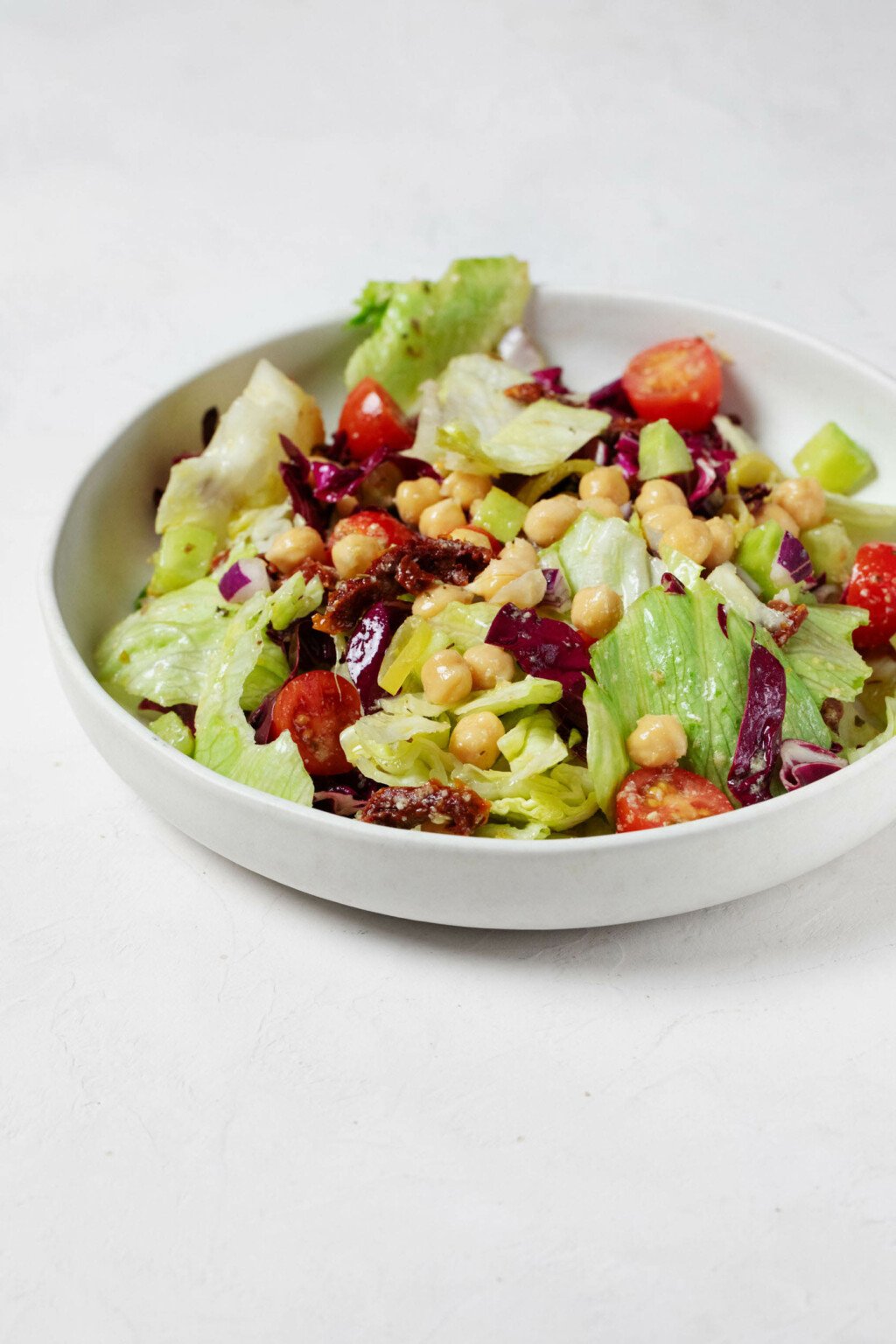
I’m hoping that this bright, zippy bowl can be a pleasant side dish for some of your upcoming meals.
It’s great with a couple slices of toast, some mushroom farro, rice or risotto, or your favorite pasta.
Now matter how you serve it, enjoy!
xo
This post may contain affiliate links. If you use these links to buy something I may earn a commission. Visit my privacy policy to learn more.
Ingredients: Chickpeas, Tomatoes
Dietary Preferences: Gluten Free, Soy Free, Vegan
Recipe Features: 30 Minute or Less

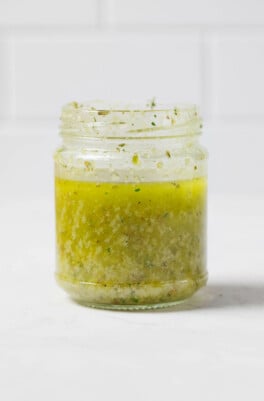
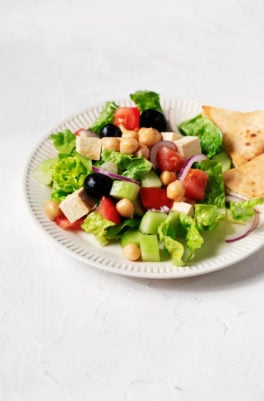
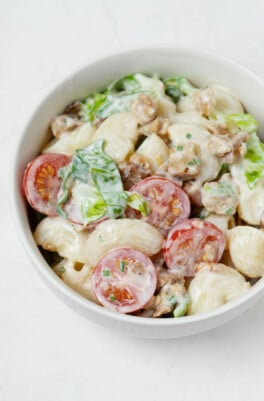
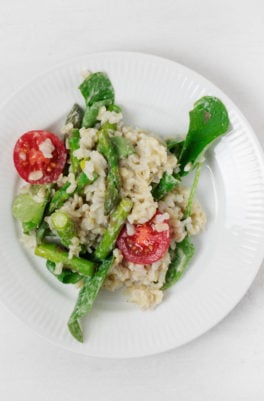
Leave a Comment
Everything about this salad is so good! The Cashew Parmesan Cheese is… totally y.u.m. Dressing is perfect! If you like the salad ingredients, you’re gonna love this one! I do! Thanks so much, Gena!
I brought this salad to a potluck and my friends ate the entire thing! It’s crunchy, tangy, and satisfying. It’s also pretty forgiving if you don’t have every single ingredient. I made it a second time without cherry tomatoes and I subbed smoked tofu for the chickpeas and it was just as delicious.
I want to like radicchio but it’s just too bitter for me, any advice for a less bitter substitute or could I skip that?
Maybe red cabbage just for color?
I think red cabbage for the color (and crunch!) is a great idea. And I actually find that escarole is another chicory that has just a touch of bitterness, but it’s not as sharp and assertive as radicchio. Hope it works out well!